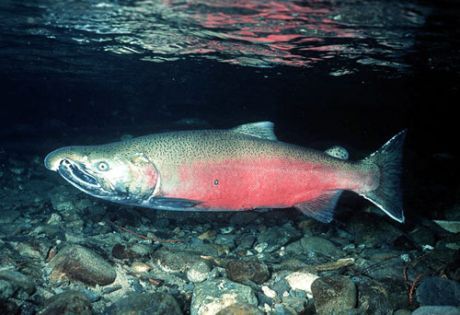News
You are here
West coast salmon stocks dwindle

October 5, 2012
As the proposed Enbridge pipeline project threatens much of the west coast’s beautiful natural landscapes and habitats, the salmon are experiencing rapid drops in their populations from profit-driven global warming and over-harvesting.
An article published in the January 2001 edition of Science found that 40-95 per cent of wild sockeye salmon that use the Fraser River to reach their spawning ground are dying, despite the reduction of their direct harvesting. A common genomic profile was found during the study and was used to make accurate predictions towards the salmons’ survivability.
Scientists believe this genomic stress has been put on the salmon because of rising water temperatures (both in rivers and ocean) and that “salmon have died in greatest numbers in ‘hotspots’ along the river system, possibly as a result of poor oxygen availability and disease.” Global warming is putting stress on Pacific salmon faster than they can adapt to it.
The International Council for the Exploration of the Sea (ICES) recently completed research on the five types of wild salmon found in the Pacific (Chinook, Chum, Coho, Sockeye, and Pink) and found that global climate change has moved many of their spawning and travel patterns—which opens them up to new or increased predation, lower and different access to food, or they become a new food competitor for another fish stock.
“Peak fish”
The problem is not isolated to the Pacific Coast. The United Nations Food and Agriculture Organization published a report with grim numbers for global fish stocks. We have reached “peak fish.” Over 52 per cent of the world`s ocean is fully exploited (which they define as “the fishery is operating at or close to an optimal yield level, with no expected room for further expansion.”).
Moreover, 17 per cent is overexploited and 7 per cent is depleted, with only one per cent being replenished from depletion. This means that only 23 per cent of the ocean could withstand more stress placed upon it, a rate much lower than fish is harvested.
Pacific salmon are some of the most exploited fish in this picture. Chinook and Coho Salmon are both ranging from fully exploited to overexploited by over 28,000 a year. The full report can be found online athttp://www.fao.org/newsroom/common/ecg/1000505/en/stocks.pdf
We live on a finite planet, but capitalism’s oil-addicted and endless drive to profit accumulation is depleting the world of its resources. There are sustainable ways to harvest fish from the sea, but only if we prioritize human and environmental need. We must look critically about who decides what we eat, and look to alternatives to the profit-driven over-exploitation of the plants and animals with whom we we share the planet.
Section:
Topics:
- Log in to post comments










